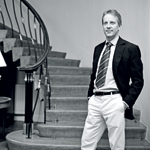Interview: Thomas Mahon
Mansel Fletcher talks to a towering talent in English tailoring


IN his work as a tailor, Thomas Mahon regularly travels to see his clients on both the east and west coasts of America, and in the great cities of Europe. Before setting up his own business, he spent a decade working at the highest level on London's Savile Row. But when he looks out of his studio window now, he can see the Cumbrian primary school he attended as a boy, and he wouldn't be anywhere else. Mr Mahon started working in London when he was 25, having been offered a job by Anderson & Sheppard (A&S).
A&S is reputedly Savile Row's grandest tailor, and is famous for the soft, flowing construction of its suits. It took Mr Mahon some time to adjust to the strictures of life there: 'One of the directors once heard me whistling in the office and he said: "Thomas, we don't have whistling in here". Another time, when it was really hot, I took my jacket off and strolled out to buy a sandwich in my shirt and braces. When I got back to the workshop, I was nearly lynched; I was told that if I went out in my underwear again, I'd be out permanently. You had to keep your coat on, regardless of the heat.' Mr Mahon admires such discip line. 'The people at A&S were brilliant at what they did, and if that's the way they wanted to behave, they had the right to do it.'
He proved adept with both a measuring tape and his tailor's shears, and was eventually so well regarded that he became the man A&S sent to the palace whenever The Prince of Wales requested a new suit from the firm. He amazed collea gues when, 12 years ago, he announced that he was leaving London to return to Warwick-on-Eden, near Car lisle. Mr Mahon explains why the distance between his studio and London is inconsequential: 'It doesn't make any difference; when I worked in London, my favourite coatmaker we call them coats, never jackets lived in Milton Keynes. His jobs were sent to him by courier at the end of one day, and he'd get them the next. I do the same from here.'
Perhaps the most amazing thing about his business is the num ber of local workers he is able to draw on. 'I've got a trouser maker who is 10 minutes away. I have local coatmakers and then I've got a finisher in Carlisle, who sews all the buttonholes by hand.' One of his coatmakers is a Cockney, who Mr Mahon lured from London to Cumbria with promises of a better life, and plenty of work.
Mr Mahon's studio is a room in Warwick Hall, a country house built in the 1930s on the River Eden. He has plans to convert part of the hall's dilapidated stable block: 'One corner is going to become tailoring workshops, for me and other craftsmen attracted to the area by its beauty, and its low rents.' Mr Mahon believes that British clothes are the best in the world and delights in casting a light on little-known firms still making first-class products. This benign nationalism his company's logo is a Spit fire is inspiring him to open a London shop later this year, where everything sold will be handmade, in Britain. 'People will pay a little more to buy good-quality British cashmere, shoes, ties and shirts.'
The internet has been vital to Mr Mahon's success, even though the old-fashioned business of tailoring seems to be at odds with the computer age. Mr Mahon's English Cut blog (www.englishcut.com) is regularly updated, and has become a useful resource for anyone interested in tailoring as a skill, or the culture and his tory of Savile Row. It's ironic that such a traditional craft is kept alive this way, but it's how his customers find him, and how he communicates with them. 'I just write down everything you ever wanted to know about tailoring, but were afraid to ask,' he says.
The English Cut blog is a successful sales tool; at the end of last year, Mr Mahon's order book was full, and he tem porarily stop ped taking on new customers. 'Bespoke suits are so amazing, they sell themselves,' he believes. 'You've just got to tell the story and the job's done.'
Sign up for the Country Life Newsletter
Exquisite houses, the beauty of Nature, and how to get the most from your life, straight to your inbox.
Country Life is unlike any other magazine: the only glossy weekly on the newsstand and the only magazine that has been guest-edited by HRH The King not once, but twice. It is a celebration of modern rural life and all its diverse joys and pleasures — that was first published in Queen Victoria's Diamond Jubilee year. Our eclectic mixture of witty and informative content — from the most up-to-date property news and commentary and a coveted glimpse inside some of the UK's best houses and gardens, to gardening, the arts and interior design, written by experts in their field — still cannot be found in print or online, anywhere else.
-
 Six rural properties with space, charm and endless views, as seen in Country Life
Six rural properties with space, charm and endless views, as seen in Country LifeWe take a look at some of the best houses to come to the market via Country Life in the past week.
By Toby Keel
-
 Exploring the countryside is essential for our wellbeing, but Right to Roam is going backwards
Exploring the countryside is essential for our wellbeing, but Right to Roam is going backwardsCampaigners in England often point to Scotland as an example of how brilliantly Right to Roam works, but it's not all it's cracked up to be, says Patrick Galbraith.
By Patrick Galbraith